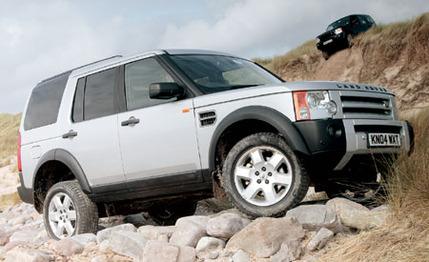
 First Drive Review
First Drive Review
At the edge of what appeared to be a cliff, we peered out the windscreen-that's Brit for windshield-of an LR3 onto a distant loch somewhere near Wick, Scotland, site of the first drive of Land Rover's Discovery replacement.
"You ready?" asked the cheerful off-road instructor. "Your Terrain Response knob should be already switched to grass/gravel/snow. Hill descent control is automatically on. Drop it into low range. When you get to the bottom, to the river, go slow and right across. Oh, and keep your feet off the pedals going down the 45-degree decline-HDC will take you down."
"No brakes?" we queried, as if that instruction must have been a joke. "And we go through the river?"
"Yes and yes. No worries-the LR3 can wade in 28 inches of water."
Gulp. As we crept over the edge, our feet pinned to the floor and our chests thrown into the locked seatbelts, there were, as it turned out, no worries, contrary to what our penny-sized pupils might have been conveying. Sure enough, the LR3 slowly and safely crawled down the slope-its anti-lock braking system pulsating with the speed of a Waterpik-and then crossed the river with the adeptness of a Scottish fly-fisher.
Land Rover proudly refers to the LR3's all-new off-road system, Terrain Response, as an "expert in the cabin." Operated via a rotary knob on the center console, Terrain Response offers five programs-general driving, grass/gravel/snow, mud and ruts, sand, and rock crawl-each of which adjusts the HDC, electronic throttle, ride height, ABS, traction control, gearchange points, stability control, and center and rear differentials for optimal performance. Around northern Scotland, we tested all five programs over appropriate terrain and found that the system performed as advertised, making us, the driver, feel like an expert. Is that what Land Rover meant?
Complementing Terrain Response are boulder-friendly approach and departure angles-37.2 and 29.6 degrees, respectively-a four-wheel independent suspension with control arms and height-adjustable air springs, and what Land Rover has dubbed Integrated Body-frame. "Fundamentally, it's a body-on-frame vehicle," commented communications director Larry Rosinski. It consists of a hydroformed, boxed-steel ladder frame and a welded steel body that's bolted to the frame through 10 rubber bushings. Land Rover says the chassis is much stiffer in the LR3, which consequently weighs at least 550 more pounds than the outgoing Discovery.
The LR3's fresh two-box design resides over a 113.6-inch wheelbase-13.6 inches longer than the Discovery's-and measures 5.7 inches longer, an inch wider, and 2.3 inches lower. As a result, much of the awkwardness that plagued the Disco is gone, replaced in the LR3 with a simple, modern design that retains the Disco's signature stepped roof yet incorporates new cues such as an "alpine" panoramic roof and a two-piece asymmetrical tailgate unmarred by a bulky spare tire.
Land Rover sees on-road competition as the BMW X5 and Lexus RX330, and the LR3 seems to have landed, figuratively, between the two-not as sporty as the X5 and not as cushy as the RX, but it nonetheless delivers an impressive ride-and-handling balance that, unsurprisingly, is akin to the civilized and athletic disposition of the 282-hp, $72,950 Range Rover, which is, by the way, 4.1 inches longer but rides on a nearly identical wheelbase.
Pushing the LR3 through curvy roads is anything but a white-knuckle experience, thanks to precise rack-and-pinion steering, powerful four-wheel vented disc brakes, and 55-series Goodyears on 19-inch wheels, which were fitted on our HSE preview vehicle.
Of course, traversing esses isn't fun without an able powertrain. Here, the LR3 excels, utilizing a 4.4-liter V-8 derived from the 4.2 that sees duty in the Jaguar XJ8. The beauty of the Ford umbrella is that it also includes Jaguar. For use in the LR3, Jag's AJ-V8 has undergone numerous alterations, notably an increase in bore from 86 millimeters to 88, a boost in oil capacity from 7.2 quarts to 9.1, revised mapping for better low-end torque, and new oil seals to guard against assaults of water and mud. Output is rated at 300 horsepower and 315 pound-feet of torque, all of which is channeled through a ZF six-speed automatic. Next year, expect to see a price leader powered by a 4.0-liter V-6.
The LR3's long wheelbase pays big inside, too, where there is a spacious third row-a two-person job that Land Rover says is suitable for six-foot-two, 215-pound adults-and enough room for 90 cubic feet of gear with the second and third rows folded flat. The LR3 has interior materials and fit and finish that would be welcome in the flagship Range Rover, as would the available Harman/Kardon Logic 7 stereo with 14 speakers and a subwoofer enclosed in the tailgate. For the directionally challenged, there's an available DVD-based navigation system. Its seven-inch LCD can also display off-road navigation-coordinates, waypoints, topography-and handy off-road info such as the direction of front wheel travel, which might just prevent having to use the LR3's front, side, and curtain airbags.
With LR3 prices opening at $44,995 for the base SE, Land Rover's biggest problem might not be moving its first-year sales forecast of almost 23,000 units, but moving the less powerful, more expensive Range Rover.